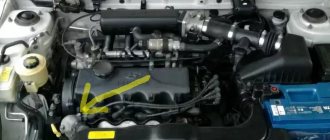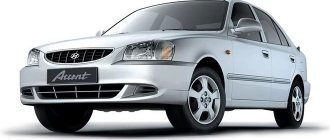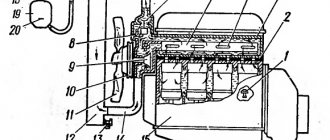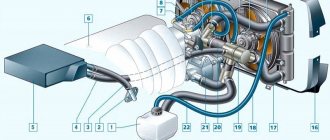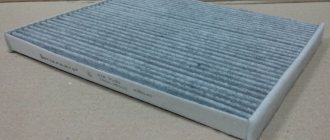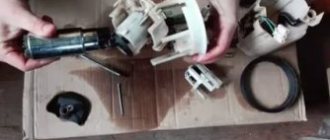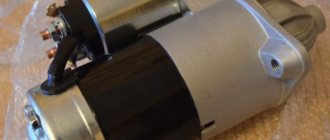07/14/2021 7,771 Cooling system
Author: Victor
Normal operation of a machine motor is possible if it is properly cooled. If you do not regularly change the antifreeze, the engine will begin to overheat during operation, and this will negatively affect its performance in the future. How often Accent antifreeze is replaced and how to change consumables with your own hands, find out from this article.
[Hide]
Cooling system Hyundai Accent
Hyundai Accent 2005, 2007 and 2008 produced by TagAZ uses cooling systems that include:
- Expansion tank. Coolant enters the system through this container.
- The lines through which the refrigerant circulates.
- A thermostat designed to turn on a large and small circle of circulation of consumables.
- Radiator cooling device for the power unit.
- A fan designed to prevent overheating of a car engine.
If one of the system components, be it a radiator or a ventilation device, fails, cooling the Hyundai Accent internal combustion engine will be impossible.
What refrigerant do I use at the factory?
According to the instruction manual, when assembling Korean cars, red coolant is poured into the cooling system. Depending on the year of manufacture and modification of the car, refrigerant manufacturers may be different. Often, Ravenol, Cool Stream Premium or Castrol liquids are poured into Accents.
Special product for flushing the cooling system
Replacement frequency, what antifreeze to fill
Based on the operating instructions, as well as the manufacturer’s recommendations, replacing antifreeze on a Hyundai Accent Tagaz must be carried out once every 40,000 km. After this period, basic functions deteriorate sharply. Protective and anti-corrosion additives stop working.
Car enthusiasts use coolant standards G12 or G11 for replacement, guided by their knowledge, as well as the advice of friends. But the manufacturer recommends using original antifreeze for Hyundai Accent.
In Russia you can find Hyundai Long Life Coolant and Crown LLC A-110 for sale. They are both original antifreezes that can be used in cars of this brand. The first is produced in Korea, and the second has a country of origin of the Russian Federation.
There are also analogues, for example CoolStream A-110 from the description, which you can find out that it is poured from the factory into cars of this brand. Another analogue of RAVENOL HJC Hybrid Japanese Coolant, which also meets the tolerances.
Source: https://autozaliv.ru/service/zamena-antifreeze/pomenyat-antifriz-hyundai-accent
Replacement intervals
In accordance with technical regulations, the procedure for changing consumables in Accents must be performed every 40 thousand kilometers. But you need to take into account that the interval can be higher or lower. Much depends on the quality of the refrigerant used and the performance of the refrigeration system.
How to determine the need for urgent refrigerant replacement?
What “symptoms” can be used to determine the immediate need to change consumables:
- The appearance of sediment in the system. Deposits most often appear at the bottom of the fluid reservoir in the engine compartment; they also collect in pipes and lines, but it is impossible to visually determine their presence without dismantling the hoses. The presence of sediment is especially obvious at low negative air temperatures.
- Increase in the freezing point of the refrigerant. If the liquid began to crystallize earlier, at higher temperatures, this indicates that it cannot cope with the functions assigned to it. For diagnostics, you can check the density of the consumable material. The test is performed using a hydrometer.
- The appearance of a yellow coating on the expansion tank plug. This also indicates that the freezing point of the refrigerant has increased.
- The consumable material has darkened and acquired a brown tint. This indicates that there are traces of rust and corrosion in the cooling system. If this is so, then the additives that are included in the consumables have lost their operational features. They can no longer form a protective film on the internal components of the cooling system.
- Refrigerant foaming. Antifreeze contains antifoam additives designed to prevent the formation of foam in the system. Its appearance indicates the need for replacement.
- Inefficient operation of the stove. If the heater is working poorly, this is especially obvious in the cold season, you need to check the functionality of the cooling system. Perhaps the reason is pipes clogged with deposits or poor antifreeze.
Replacing antifreeze on a Hyundai Accent: how and when to do it
In this short article we will tell you when and how to replace antifreeze on a Hyundai Accent. If you follow the technical regulations, then it is necessary to completely replace the fluid once every 40 thousand kilometers. But keep in mind that this is according to the regulations; in fact, the interval can either decrease or increase. And the most important role in this is played by the quality of antifreeze and the efficiency of the entire system. Let's start with how to understand that it's time to change the fluid in the Hyundai Accent cooling system.
Signs that antifreeze needs to be replaced
Let us highlight several symptoms that indicate that the cooling system is filled with deteriorating liquid:
- Precipitate appears in the system. It can be observed directly in the expansion tank. If you are repairing the system, pay attention to whether there is sediment in the lines and pipes. The fact that there is sediment in the system manifests itself clearly, as a rule, at low air temperatures - the engine warms up worse.
- The freezing point of antifreeze increases. If crystallization occurs at temperatures above -40 degrees, this indicates that it does not fulfill its functions. To be sure, check the density of the liquid with a hydrometer.
- A yellowish coating forms on the inner surface of the expansion tank plug. This symptom also appears when the freezing point of antifreeze increases.
- When corrosion and rust appear inside the Hyundai Accent cooling system, antifreeze acquires a brown tint and gradually darkens. In this case, we can say that the additives present in the liquid have evaporated and no longer work.
- Foaming is observed. It is worth paying attention to the fact that modern antifreezes contain anti-foam additives. The appearance of foam indicates that the liquid cannot cool properly and the engine may overheat.
- The heater is not working well. In this case, it is imperative to check the functioning of the entire cooling system. Very often the reason for this behavior of the stove is the presence of deposits inside the lines and pipes. Sometimes this happens due to low quality antifreeze.
Which coolant is better to choose?
To effectively cool a car engine, high-quality antifreeze must be used. Antifreeze may be added to more worn engines, but domestically produced products are not recommended for use in foreign cars. Exact recommendations regarding the use of refrigerant of a particular standard are indicated in the service book; they may vary depending on the type of engine and year of manufacture of the car.
In newer ones, the automaker recommends filling in red G12 class refrigerant, developed on the basis of ethylene glycol.
Red Felix G12 refrigerant
Coolant replacement
According to the manufacturer's recommendation, the coolant should be replaced after 2 years of operation or after 40 thousand km, whichever comes first. The fluid in the cooling systems of both engines is changed using almost the same techniques, so the work is shown using the example of a mod engine. G4EC.
You will need: coolant, a clean rag, a container for drained coolant with a capacity of at least 10 liters, and pliers.
Use only coolants recommended by the manufacturer (see Appendix 3).
Replace coolant only when the engine is cold.
Coolant is toxic, so be careful when handling it.
When starting the engine, the expansion tank cap must be closed.
When the engine is running, the cooling system is under pressure, so coolant may leak from under a loose radiator filler cap.
1. Place the vehicle on the inspection ditch.
2. Remove the expansion tank of the engine cooling system by disconnecting the radiator steam hose from it, drain the liquid from it and install it in place (see “Removing and installing the expansion tank”).
Whenever you remove the engine cooling system expansion tank, flush it if possible to remove any deposits that have accumulated in it.
4. Remove the radiator filler cap by turning it 90 degrees counterclockwise.
5. Place a container under the drain hole of the radiator of the cooling system, remove the drain plug...
6. ...and drain the coolant from the radiator.
Antifreeze is deadly poisonous to all living things. In order not to pollute the environment, drain it from the radiator through a funnel (for example, made from a plastic bottle).
8. Squeeze the tendrils of the clamp, slide it along the hose (in the photo, the radiator outlet and inlet hoses have been removed for clarity)…
9. ...disconnect the hose going to the water pump from the thermostat housing branch pipe and drain the remaining coolant from it into a previously prepared container.
10. Connect the hose to the pipe and tighten the radiator drain plug.
11. Fill the radiator with coolant to the bottom edge of the filler neck. Install the filler plug by turning it 90° clockwise.
12. Lift the cap of the expansion tank by the tongue, remove it from the filler neck...
13. ...and fill the liquid to the upper “F” mark.
14. Start the engine and warm it up to operating temperature (before the fan turns on). After this, stop the engine, check the coolant level and, if necessary, add it to the expansion tank to the “F” mark.
When the engine is running, monitor the coolant temperature according to the gauge. If the arrow reaches the red zone and the radiator fan does not turn on, turn on the heater and check what kind of air passes through it. If the heater supplies heated air, the fan is most likely faulty; If it supplies cold air, it means that an air lock has formed in the engine cooling system. To remove it, turn off the engine, let it cool and unscrew the radiator filler cap. Start the engine, let it run for 3-5 minutes and tighten the radiator cap.
To better fill the system without air locks, periodically squeeze the radiator hoses by hand.
After a few days of using the car after replacing the coolant, check its level. Replenish it if necessary.
If after a very short time the color of the fresh liquid turns brown, it means that you have filled it with a fake, to which you have added corrosion inhibitors. In addition, one of the signs of a fake is a sudden complete discoloration of the liquid. Good quality coolant dye is very durable and only darkens over time.
Source: https://www.automnl.com/model/hyundai_accent1/79/
Level control and required volume
The car owner needs to know how much fluid to fill in order to purchase the appropriate container with the product. Depending on the volume of the power unit, the amount of refrigerant will differ. Engines with a volume of 1.4 and 1.5 liters are filled with 5.5-5.8 liters of the substance. 1.3-liter units produced up to and including 2003 also contain 5.5 liters of liquid. And if an engine of the same volume was produced in 2004 and later, then 6.2 liters of refrigerant will be required to refill the cooling system. Power units with a volume of 1.6 liters must be filled with at least 6.5 liters of antifreeze.
To control the consumable level, the machine engine must be turned off and cooled. When the power unit is warm, some of the refrigerant may escape into the reservoir. As a result, the level of consumables will be overestimated. Open the hood and take a look at the reservoir. Ideally, the refrigerant volume should be between the MIN and MAX marks or at the F mark in the reservoir.
Possible causes of coolant consumption
There are several reasons why coolant consumption may occur:
- During the winter season, when sub-zero temperatures prevail, the refrigerant tends to decrease in volume. If it's freezing outside, you'll have to replenish the refrigerant more often.
- The appearance of damage and cracks in the tank or on the expansion tank cap. If the defect is minor, it cannot be seen with the naked eye. You will have to dismantle the container and carry out detailed diagnostics.
- Depressurization of connecting points on highways or damage to pipes. Over time, hoses tend to wear out, which leads to the formation of defects on them. Due to damage, the refrigerant leaves the cooling system. Sometimes the thermostat gasket also wears out.
- Malfunctions in the operation of the radiator device of the heating system. During operation, the car radiator wears out and defects may appear in its design. Coolant leaves the system through damaged areas.
- Refrigerant boiling. This is due either to overheating of the engine, which leads to boiling of the liquid and, as a result, a decrease in its volume, or to the loss of antifreeze performance properties.
- Refrigerant getting into the engine fluid. Antifreeze usually gets into the oil as a result of a damaged cylinder head gasket. To solve the problem, you need to remove the cylinder head and change the seal.
Kala Auto Search Engine has published a video that will allow you to correctly determine the presence of an emulsion in the cooling system of a Hyundai Accent.
What will you need for replacement?
So, now in more detail about how to replace antifreeze on a Hyundai Accent with your own hands. To carry out the work you need to purchase:
Concentrated antifreeze based on ethylene glycol - these work great in aluminum engines. The volume of liquid is no more than 3 liters.
- 20 liters of distilled water.
- Pan (you will need to drain the old fluid into it).
- Small watering can.
- Pit, overpass (if possible).
The procedure is simple, but it takes three hours, or even more. First you need to perform the following manipulations:
- Remove the expansion tank by unscrewing the two mounting bolts.
- Pour out the old fluid and clean the inside.
- Reinstall the tank.
- You can drain the liquid from all pipes. But there is little point in this, just disturb the clamps. And dismantling the pipes is very problematic.
We recommend: How to choose and change the automatic transmission oil of a Hyundai solaris: photos and instructions
Replacing antifreeze with your own hands
You can replace the refrigerant in a garage, we will talk about this below.
Tools and materials
To change the fluid you will need:
- new refrigerant, determine the container volume in accordance with the engine specification;
- a basin or bucket into which you will drain the “working off”;
- cleaning agent or distilled water;
- rags;
- set of wrenches.
How to drain?
First, we drain the consumables from the cooling system:
- Drive the car into a garage with a pit or onto an overpass. It is important that the Hyundai Accent is located on a flat surface.
- Open the hood of the car and unscrew the plug on the heat exchanger. Remove it and set it aside.
- Locate the coolant expansion tank in the engine compartment. Unscrew the lid on it.
- Find the pipe connected to the heat exchanger, then place a container under it into which the used antifreeze will be drained.
- Carefully unscrew the plug located on the radiator unit a few turns using a wrench. This will allow you to drain the refrigerant from the cooling system. There will be traces of leaks in the area of the drain hole; they should be wiped with a rag.
- Screw the drain plug into place.
Flushing the system
To properly change consumables, the cooling system must be flushed:
- For cleaning, you can use special antifreeze or distilled water. Fill the cooling system with clean distillate through the expansion tank and screw on the cap. Water must be added until its level rises to the steam outlet line.
- Start the engine and warm it up to operating temperature. When the engine is completely warmed up, you will hear the fan turn on.
- Stop the power unit and perform the drain procedure again.
- Assess the quality of the fluid drained from the cooling system. If there are traces of rust and deposits in the water and it is far from clear, then the washing procedure should be repeated again. Cleaning is carried out until perfectly clean water comes out of the system when drained. To flush the system, only distilled water is allowed.
- Remove the expansion tank and wash the inside of it to remove dirt.
The Diman and cars channel, using the example of a Hyundai Getz car, offers to familiarize yourself with the process of replacing the refrigerant and flushing the cooling system. In the case of Accent, the process will be performed similarly.
How to fill?
To fill the refrigerant, do the following:
- Tighten the drain plug.
- Slowly pour new antifreeze into the radiator neck. The liquid is poured until its level rises to the steam outlet line.
- Start the power unit and wait until it warms up, this will be indicated by the start of the cooling fan.
- Look at the refrigerant level in the expansion tank. If it begins to fall, this indicates that air pockets are coming out of the cooling system. When the level drops in the radiator device, add consumables a little at a time. In this case, you can compress the pipes connected to it, this will remove air from the lines.
- Wait a few more minutes and check the refrigerant level. The addition procedure can be repeated up to 6 times until air pockets leave the system.
- Tighten the plug on the radiator device.
- Perform a test drive and check the level again. If necessary, add refrigerant to the system. The liquid is poured until it reaches level “F” or between the MIN and MAX marks on the expansion tank.
All about replacing refrigerant
Before proceeding directly to the process of replacing antifreeze on a Hyundai Accent, you need to understand that the volume on each Accent engine is different, so you need to prepare a container measuring from 7 to 10 liters. We purchase the antifreeze itself and begin the replacement process.
- The first step is to drain the antifreeze.
- To do this, we drive a car pit or overpass, and place it on a flat surface.
- Don't forget that you need to let the car cool down.
- At the bottom of the radiator on the right we see a drain plug, unscrew it, and wait until the old antifreeze flows into the prepared container.
- After the antifreeze has been drained from the cooling system, it is recommended to flush the cooling system. But not every motorist does this; even car repair shops may not do this.
- To flush, you need to pour a special liquid purified antifreeze into the system, or there are special products sold in stores for cleaning the cooling system.
- After this, you need to start the engine and boil it to operating temperature, when the power unit is warmed up, you finally need to turn off the engine.
- We give our word to the cars at the pharmacy and drain the flushing antifreeze.
- After the system has been cleaned, you can fill it with new antifreeze.
- To do this, you need to tighten the drain plug, unscrew the filler neck and fill in the required amount of liquid.
- After the required amount of coolant has been filled in, you need to start the engine and let it run for 7-10 minutes.
- After this, we check the coolant level; if it drops, it means that air has left the system.
Now add antifreeze to the required amount.
Consequences of untimely replacement
Briefly about the consequences that are fraught with a car in case of untimely replacement of the refrigerant:
- Deposits will begin to form on the internal components of the cooling system. Their presence can lead to corrosion and destruction of metal components. Most often the pump suffers.
- The composition of the consumable material changes, and its boiling point decreases. The product loses its properties and cannot perform its intended functions. Cooling of the power unit will be less efficient, which can lead to overheating.
- Frost resistance properties are reduced. If previously the refrigerant froze at -40 degrees, now the temperature threshold for crystallization can be about -25 degrees. As a result, the liquid will solidify in cold weather. Due to its ability to expand in this state, you may encounter the problem of damage to the pipes and expansion tank.
How to determine the urgency of replacing the coolant
There are a number of symptoms and signs that indicate an urgent replacement of the coolant:
- The first sign is the appearance of sediment in the system, deposits at the bottom of the fluid reservoir in the engine compartment.
- If the freezing point of the refrigerant has increased - This means that the liquid began to crystallize earlier and at higher temperatures this indicates that it needs to be replaced.
- A yellow coating appears on the expansion tank plug.
- The antifreeze has acquired a brown tint - this means that the system has traces of rust and corrosion.
- Foaming of the refrigerant means that the coolant has lost its physical and chemical properties and requires urgent replacement.
Poor performance of the heater may be a sign that the coolant needs to be replaced.
As can be seen from the article, replacing coolant on a Hyundai Accent is quite simple, but it is worth considering that there are many subtleties and nuances that need to be taken into account when carrying out the process. Do not forget about choosing a high-quality refrigerant, since the internal state of the elements of the power units, as well as other elements and performance, will depend on this.
Source: https://koreanautoreview.com/hyundai/accent/zamena-antifreeza-akcent.html
Photo gallery
Photo of replacing the refrigerant in a Hyundai Accent.
1. Removing the heat exchanger plug
2. To drain the refrigerant, unscrew the plug on the radiator unit
3. Drain the refrigerant
4. Flush and fill with new fluid
Coolant replacement
According to the manufacturer's recommendation, the coolant should be replaced after 2 years of operation or after 40 thousand km, whichever comes first. The fluid in the cooling systems of both engines is changed using almost the same techniques, so the work is shown using the example of a mod engine. G4EC.
You will need: coolant, a clean rag, a container for drained coolant with a capacity of at least 10 liters, and pliers.
Use only coolants recommended by the manufacturer (see Appendix 3).
Replace coolant only when the engine is cold.
Coolant is toxic, so be careful when handling it.
When starting the engine, the expansion tank cap must be closed.
When the engine is running, the cooling system is under pressure, so coolant may leak from under a loose radiator filler cap.
1. Place the vehicle on the inspection ditch.
2. Remove the expansion tank of the engine cooling system by disconnecting the radiator steam hose from it, drain the liquid from it and install it in place (see “Removing and installing the expansion tank”).
Whenever you remove the engine cooling system expansion tank, flush it if possible to remove any deposits that have accumulated in it.
4. Remove the radiator filler cap by turning it 90 degrees counterclockwise.
5. Place a container under the drain hole of the radiator of the cooling system, remove the drain plug...
6. ...and drain the coolant from the radiator.
Antifreeze is deadly poisonous to all living things. In order not to pollute the environment, drain it from the radiator through a funnel (for example, made from a plastic bottle).
8. Squeeze the tendrils of the clamp, slide it along the hose (in the photo, the radiator outlet and inlet hoses have been removed for clarity)…
9. ...disconnect the hose going to the water pump from the thermostat housing branch pipe and drain the remaining coolant from it into a previously prepared container.
10. Connect the hose to the pipe and tighten the radiator drain plug.
11. Fill the radiator with coolant to the bottom edge of the filler neck. Install the filler plug by turning it 90° clockwise.
12. Lift the cap of the expansion tank by the tongue, remove it from the filler neck...
13. ...and fill the liquid to the upper “F” mark.
14. Start the engine and warm it up to operating temperature (before the fan turns on). After this, stop the engine, check the coolant level and, if necessary, add it to the expansion tank to the “F” mark.
When the engine is running, monitor the coolant temperature according to the gauge. If the arrow reaches the red zone and the radiator fan does not turn on, turn on the heater and check what kind of air passes through it. If the heater supplies heated air, the fan is most likely faulty; If it supplies cold air, it means that an air lock has formed in the engine cooling system. To remove it, turn off the engine, let it cool and unscrew the radiator filler cap. Start the engine, let it run for 3-5 minutes and tighten the radiator cap.
To better fill the system without air locks, periodically squeeze the radiator hoses by hand.
After a few days of using the car after replacing the coolant, check its level. Replenish it if necessary.
If after a very short time the color of the fresh liquid turns brown, it means that you have filled it with a fake, to which you have added corrosion inhibitors. In addition, one of the signs of a fake is a sudden complete discoloration of the liquid. Good quality coolant dye is very durable and only darkens over time.
Source: https://www.automnl.com/model/hyundai_accent1/79/
Video “How to change consumables in a Hyundai”
Using the Hyundai Elantra model as an example, user DRAMATURG11 suggests familiarizing yourself with the process of replacing the coolant; in the case of the Accent, the procedure will be similar.
Do you have any questions? Specialists and readers of the AUTODVIG website will help you ask a question
Was this article helpful?
Thank you for your opinion!
The article was useful. Please share the information with your friends.
Yes (100.00%)
No
X
Please write what is wrong and leave recommendations on the article
Cancel reply
Rate this article: ( 4 votes, average: 5.00 out of 5)
Discuss the article:
Replacement of the cooling system for other Hyundai categories
In cars of other Hyundai categories, the method of replacing coolant is practically the same. To change antifreeze on a Hyundai Solaris or Hyundai Getz, you can follow the above recommendations; the procedure is carried out according to the same algorithm. On Hyundai Verna, replacing antifreeze is also similar to the procedure described.
Car enthusiasts who are interested in replacing Accent Drive2 antifreeze can follow the algorithm proposed above, however, minor differences are still present. The differences between Accent Drive2 and other Hyundai models are in the location of the tank, radiator and drain holes.
Leaks and problems
Over time, your car needs to pay close attention to the pipes and hoses. They may begin to dry out and crack. What causes a leak to form, the worst thing is when it happens on the road, where you can’t get to a service center or a spare parts store.
The radiator filler cap is considered a consumable and therefore must be changed periodically. Because due to a soured bypass valve, the pressure in the system may increase, which will lead to a leak in the cooling system at a weak point.
Rarely does anyone pay attention to these little things, but they are the ones that can lead to problems with the cooling system.
Checking the coolant level of a Hyundai Accent
The expansion tank is installed in the engine compartment on the right mudguard. To check the fluid level, place the car on a flat horizontal platform. The fluid level in the expansion tank should be checked on a cold engine.
There are marks “F” and “L” on the tank, between which the fluid level should be on a cold engine. When the engine is warmed up to operating temperature, the coolant level in the reservoir may be slightly above the “F” mark. If the level is at the “L” mark or below, add fluid recommended by the manufacturer to the tank. After opening the radiator cap of a Hyundai Accent, check the fluid level and top up if necessary. If you need to add fluid to the system while the engine is warm, you must stop the engine. Lift the cap of the expansion tank by the tongue and remove it from the neck of the tank.
Add coolant to the tank, slightly below the “F” mark. Warning:
Coolant is poisonous.
Coolant that gets on engine parts or paintwork must be removed with a rag. Then close the expansion tank with a lid. Attention: If the fluid level in the reservoir is constantly decreasing, then there is most likely a leak in the system. In this case, it is necessary to check the tightness of the cooling system and eliminate the malfunction (see “Cooling system”).
Source
How to change coolant
The difficulty of changing the coolant on a Hyundai Accent is that the coolant can only be drained through the radiator, because there is no drain plug on the tank. Replace only when the engine has completely cooled down.
- The car must be installed on a horizontal surface. Unscrew the plug
- It is necessary to lift the hood and unscrew the heat exchanger plug. Then remove it and put it next to it. Remove the plug
- Unscrew and remove the plug from the filler hole of the expansion tank. Unscrew the tank cap
- We place a container under the heat exchanger tap hose to drain the coolant. We place a container to drain the old refrigerant
- Carefully unscrew the drain plug on the radiator three to four turns and wait for the used coolant to drain. To drain the used antifreeze, unscrew the radiator plug
- Be sure to wipe away possible coolant leaks near the drain hole.
- We tighten the drain plug.
- We flush the cooling system.
- Pour clean water into the coolant reservoir hole.
- Pour until the refrigerant level rises to the steam pipe.
- We turn on the engine and wait until the electric fan turns on.
- We turn off the engine and drain the water.
- This procedure can be repeated several times until clean water begins to drain.
How to fill
- You need to pour coolant into the radiator neck slowly.
- We pour until its level rises to the level of the steam pipe.
- Turn on the motor and let it run until the electric fan starts.
- If the coolant in the radiator begins to decrease, this may mean that air is gradually beginning to escape from the system. At this time, you need to carefully and little by little pour antifreeze into the radiator.
- This procedure can be repeated 4 to 6 times (wait until the air is completely released).
- We tighten the radiator cap.
- Add antifreeze to the required level “F”, which is indicated on the tank. Add coolant to the expansion tank
To ensure that there are no air pockets in the cooling system, it is necessary to tighten the radiator hoses while filling it.
How to select and replace antifreeze on a Hyundai Accent: photos and instructions
The process itself is quite simple, but it takes hours.
HOW OFTEN DO YOU NEED TO CHANGE ANTIFREEZE?
Any ethylene glycol-based antifreeze for an aluminum engine will also work. Remove the expansion tank of the engine cooling system by disconnecting the radiator steam hose from it, drain the liquid from it and reinstall it, see.
If the arrow reaches the red zone and the radiator fan does not turn on, turn on the heater and check what kind of air passes through it. For the engine cooling system to function flawlessly, a high boiling point of the coolant is required. Since the radiator neck is the highest point in the system, air traveling through the system will come to this place and exit.
This way we gradually wash out the old antifreeze and we will have clean distilled water in the system. After draining the liquid for the last time, pour 3 liters of concentrate into the radiator; if it doesn’t fit, we pour it into the expansion tank.
Next, we need to finally mix the concentrate and water in the engine, adjust the fluid level in the tank and bleed air from the system. It is believed that these processes will occur naturally while driving. And if the engine temperature needle remains in the middle of the scale, then everything is ok, and the work can be considered complete.
